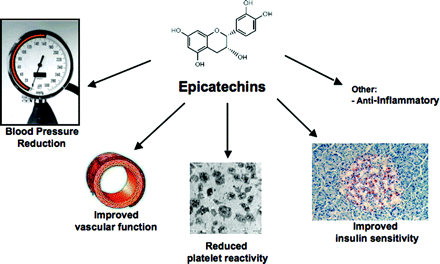Is Chocolate Good For You? The Health Benefits of Chocolate

Theobroma cacao, the Latin name for chocolate, means “Food of the Gods” for a reason. It’s a heavenly way to lift your performance. There’s also some major health benefits of chocolate.
We’re not talking about junk chocolate in candy bars and sweet desserts; dark chocolate has a long history as a healing plant, a mood enhancer, and even an aphrodisiac. So you’re in luck: you can indeed use high-quality chocolate to take delicious control of your biology.
7 health benefits of chocolate
You’ve probably read that chocolate affects your brain by causing the release of the “happiness neurotransmitters” serotonin, dopamine, and endorphins.[1] Like coffee, chocolate is also a potent source of polyphenol antioxidants, which can fight damaging free radicals and protect your mitochondria.
But experienced chocolate hackers also know chocolate to be a useful tool for improving performance in lesser-known ways. In fact, cacao exerts a systemic effect on the body, with benefits ranging from improved blood flow and cognition to beneficial alterations in gut bacteria! Here are some of the most important benefits of chocolate (besides taste…).
1. Chocolate for a better mood
Chocolate can improve your mood, especially in high-pressure or stressful situations.[2] Participants were asked to complete serial subtraction tasks of threes and sevens (counting down by 3s and 7s), and a rapid visual information-processing task to test sustained attention. Those who consumed cocoa flavanol drinks prior to the trial had overall better cognitive performance and reported less mental fatigue than the control group.
2. Chocolate makes you eat less
One of my favorite effects of chocolate consumption is a reduction in appetite. One study quantified this by giving participants a 100 g serving of either milk or dark chocolate two hours before being served an all-you-can-eat lunch.[3] Ingestion of dark chocolate was correlated with a 17% lower calorie intake at the following meal, compared to the milk chocolate group. (I’d imagine that it’s because the casein in milk binds to the polyphenols in chocolate, making them unavailable to your body.)
Chocolate may also have a significant effect on mood, as one double-blind study recorded that subjects were able to subjectively discriminate the effects of theobromine at doses as low as 100-560 mg.[4]
3. Chocolate for a healthy heart
Regular chocolate consumption can improve your cardiovascular health.[5] Notably, the polyphenols in cacao increase HDL cholesterol (often thought of as the protective kind of cholesterol), which in turns leads to decreased oxidized LDL cholesterol.[6][7] Other effects include higher levels of circulating nitric oxide,[8][9] and reduced platelet adhesion,[10], resulting in improved circulation.
One study even found the cacao flavanol epicatechin to be responsible for the rise in nitric oxide, which is essential for vascular health.[11] Bioavailability of nitric oxide is an essential determinate of vascular health as it regulates dilation tone, signals cell growth and inflammatory response, and protects blood vessels from clotting.[12]
Vascular function is also really important for insulin-regulated glucose uptake.[13] That’s why dark chocolate can support healthy levels of insulin sensitivity.[14]

4. Chocolate for glowing skin and sun protection
Chocolate can help you maintain healthy skin by modulating healthy blood flow. In one study, two groups of women consumed either a high flavanol or low flavanol cocoa powder for a period of 12 weeks. While the low flavanol group showed no change in markers of skin health, subjects in the high flavanol group had on average 25% reduction in UV-induced erythema (sunburn) after exposure to a solar simulator.[15]
The high flavanol group also recorded increased skin density and thickness, as well as better hydration and less transepidermal water loss.
5. Chocolate may lower inflammation
Chocolate may have some inflammation-modulating properties. In one study, obese mice supplemented with cocoa powder had less obesity related inflammation markers and less insulin resistance.[16] These mice also had a 30% reduction in plasma levels of the major pro-inflammatory mediator interleukin 6. Additionally, a cross-sectional study of an Italian cohort discovered an inverse relationship between dark chocolate consumption and serum C-reactive protein.[17]
6. Chocolate is a prebiotic
While many studies assume that it is the cacao polyphenols acting directly to modulate biomarkers, it is most likely the case that at least some of the effect is indirect, and works through interaction with our gut microbiome. Research suggests that low molecular weight cocoa flavanols such as epicatechin and catechin can be absorbed directly into blood circulation,[18] (unless you mix them with milk) but this is not so for the larger polyphenols. In this case, microflora in the colon work to break down high molecular weight polyphenols, so that the smaller secondary metabolites may circulate throughout the body.[19][20]
See Figure 2. Cocoa flavanols are processed by gut microbiota, and secondary metabolites can enter circulation.

If gut bacteria are feeding on the larger cocoa polyphenols, then it follows that they can also change the composition of the intestinal microbiome. In fact, one study did discover a beneficial prebiotic effect of high flavanol chocolate consumption. After a period of 4 weeks of consuming a high flavanol cocoa powder, subjects had a significant increase in bifidobacteria and lactobacilli populations, as well as significantly decreased clostridia levels.[21] This was accompanied by significantly decreased C-reactive protein (which correlates to inflammation reduction in the body), which was associated particularly with changes in lactobacilli.
7. Chocolate for anti-aging
Last, but certainly not least, cacao can enhance mitochondrial biogenesis, or, the creation of new mitochondria! It is important to have healthy mitochondria, and more of them. It is the flavanol epicatechin in chocolate which is responsible for mitogenesis. In one study, oral administration of epicatechin to senile mice shifted numerous biomarkers towards those of young mice, including sirtuin 1, a well-recognized regulator of mitochondrial biogenesis.[22][23] In another mouse study, treatment with epicatechin improved exercise performance by ~50% compared to controls, and enhanced muscle fatigue resistance by ~30%.[24] The epicatechin group also recorded significant increases in mitochondrial volume in hindlimb and cardiac muscles.
Does chocolate have caffeine?
Yes, but in much smaller amounts than coffee. So much less, you could probably eat a square or two of dark chocolate before bed without any trouble falling asleep. The really cool energy-giving molecule in coffee is called theobromine. Theobromine is the primary alkaloid found in cocoa that is responsible for multiple positive effects, one of which is similar to the affects of caffeine. Theobromine is present in a high concentration in dark chocolate, measuring between 237-519 mg per 50g.[25]
The benefits of theobromine
Promotes steady energy: Due to the molecular makeup of theobromine, while it promotes energy in the body, it doesn’t exert its effects on the central nervous system – so its effects are a more gentle, feel-good type of energy. Also, due to its molecular makeup, theobromine takes longer to clear from your body, which means this calm energy lasts longer.
Better cognitive function: The immediate cognitive effects of chocolate are primarily accounted for by caffeine and theobromine. A study comparing the effects of cocoa powder versus an equivalent caffeine and theobromine powder found equivalent improvements in cognitive and mood assessments.[26]
Addictive taste: It is said that dark chocolate is an “acquired taste,” and research suggests that theobromine may be the component responsible for our attraction to dark chocolate. One study demonstrated an increased liking for a ‘novel’ drink when it was mixed with theobromine.[27]
The pitfalls of chocolate
Most chocolate contains sugar
By now you may be interested in picking up some chocolate, but be sure to choose one with as little sugar as possible or even none.
While research shows that cocoa can have a beneficial effect with regards to maintaining healthy vascular tone and insulin sensitivity, the reverse is true for sugar. Eating sweetened chocolate is still not good for you. Beware of chocolate marketed as “sugar-free” that may contain unhealthy artificial sweeteners, which are found in the “kryptonite” zone of the Bulletproof Diet Roadmap.
In one study, rats fed a high-fat, high-sucrose diet for 4 weeks displayed insulin resistance, and decreased endothelial nitric oxide synthase (eNOS), which is responsible for creating nitric oxide in blood vessels.[28]
Chocolate can contain mold
Unfortunately, due to intensive farming techniques and poor agricultural, processing, and storage practices, much of the world’s chocolate supply is contaminated with meaningful levels of mold toxins. One of the more insidious and dangerous forms of mycotoxin, ochratoxin A, was present in 98% of Brazilian chocolate samples tested in one study.[29] Of those contaminated with ochratoxin, the study found an 80% co-occurrence of aflatoxin as well. Mycotoxins amplify each other when more than one is present.
Cacao trees are a tropical crop, making them highly susceptible to fungus and mold.[30] Roasting moldy beans destroys the actual fungi, but it doesn’t destroy the fungi’s byproduct: harmful mold toxins. Beans aren’t just susceptible when they’re on the tree. They can become host to mold and fungi during pre-processing, so it’s important not to let them sit for long periods of time.[31] The good news is that one study found that the processing of cocoa beans into a finished product resulted in a 93.6% decrease in ochratoxin A.[32] My experience is that mold toxins vary greatly from batch to batch and from brand to brand, and a brand with “clean” chocolate this month may not be clean the following month.
Keep the following in mind while selecting and eating chocolate:
- Make sure your chocolate is at least 85 percent dark chocolate
- European chocolate tends to be lower in mold toxins, as they have stricter government limits than the US
- Take activated coconut charcoal with chocolate to bind some of the mold toxins like I always do
How to get more chocolate into your day
Your options are almost limitless. Try these unique options to get more chocolate into your diet:
- Drink cacao tea
- Make a Bulletproof Mocha: add some high-quality chocolate powder to your morning BP coffee
- Make Bulletproof Get Some Ice Cream
- Whip up a batch of Keto Chocolate Chunk Blondies
- Enjoy a few squares of a keto-friendly chocolate bar for a sugar- and sin-free treat before bed.
No matter which route you choose, you can certainly satisfy your chocolate craving without going overboard on carbs and sugar. It just comes down to how creative you want to get in the kitchen—and how long you’re willing to wait to sink your teeth into some chocolatey goodness!
Sign up for early access to sales, product launches, the latest Bulletproof news and more!



